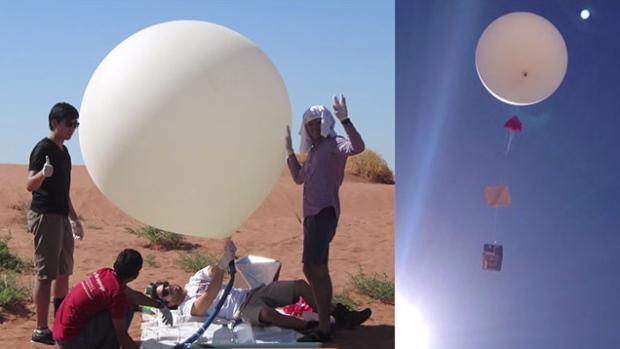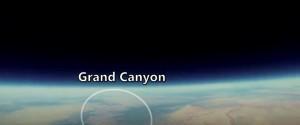 In December of 2014, 3DPrint.com covered the development of a 3D printed capsule designed specifically to hold a camera that would then be attached to a weather balloon, for the purpose of getting some amazing photos and videos from the stratosphere. Capsules like these have been used in experiments for a couple of years, with mixed results. In June of 2013, Stanford University students Bryan Chan, Ved Chirayath, Ashish Goel, Tyler Reid, and Paul Tarantino launched a weather balloon containing a GoPro camera in a 3D printed capsule over the Grand Canyon. Their goals were numerous, from gathering data for Chirayath’s research on fluid lensing to simply getting some pretty cool pictures from space.
In December of 2014, 3DPrint.com covered the development of a 3D printed capsule designed specifically to hold a camera that would then be attached to a weather balloon, for the purpose of getting some amazing photos and videos from the stratosphere. Capsules like these have been used in experiments for a couple of years, with mixed results. In June of 2013, Stanford University students Bryan Chan, Ved Chirayath, Ashish Goel, Tyler Reid, and Paul Tarantino launched a weather balloon containing a GoPro camera in a 3D printed capsule over the Grand Canyon. Their goals were numerous, from gathering data for Chirayath’s research on fluid lensing to simply getting some pretty cool pictures from space.
The experiment, it soon turned out, was a bust, despite months of careful preparation and research. The balloon launched successfully, and traveled nearly 100,000 feet high before coming down 50 miles away from the launch point. Unfortunately, the results were lost due to one of the most universal frustrations of the developed world: loss of cell phone coverage.
To track the balloon’s flight, the team had attached a GPS-equipped smartphone to the capsule. With the ubiquity of cell phone towers, they didn’t expect it to land in a zero-coverage area, which is, of course, exactly what happened. Their project ended up somewhere in the middle of the Arizona desert, with the GPS inaccessible and thus no way for the students to access their balloon.
“We planned our June 2013 launch at a specific time and place such that the phone was projected to land in an area with cell coverage,” said one of the students, identified by the user name trexarmsss, in a Reddit post. “The problem was that the coverage map we were relying on (looking at you, AT&T) was not accurate, so the phone never got signal as it came back to Earth, and we never heard from it.”
 AT&T, however, redeemed themselves, if accidentally. Two years after the failed experiment, an AT&T employee was hiking in the desert and stumbled upon the crashed balloon. Using the data from the phone’s sim card, the woman was able to track down the students and return their project to them.
AT&T, however, redeemed themselves, if accidentally. Two years after the failed experiment, an AT&T employee was hiking in the desert and stumbled upon the crashed balloon. Using the data from the phone’s sim card, the woman was able to track down the students and return their project to them.
“We did have a backup transponder on board,” Reid noted, “which broadcast in the amateur radio band, but this proved too faint to be of use. The payload ran out its batteries and lay dormant in the desert for nearly 2 years. By some miracle, a hiker found our payload but unfortunately all identifying marks had worn off or blow away. It seems that cattle trampled our payload at some point, destroying most of the styrofoam box and 3D printed housing.”
The capsule and balloon were pretty beat up, due to the potential cattle romping, but the footage and data were intact. And what footage it was. When the students recovered the camera, they discovered a stunning video of the Grand Canyon from space. Watching the video, the viewer can see the dusty Arizona desert slowly recede as the balloon rises. Slowly, the curve of the Earth becomes visible, and a panoramic view from space appears. Watch the abridged version of the video below:
“We were blown away, absolutely blown away,” Chan told Canada’s CBC Radio upon retrieving the lost footage. “I was absolutely floored by the stuff we got.”
Want to try a weather balloon experiment yourself? A 3D printed balloon capsule is inexpensive, and, as the Stanford students discovered, highly durable, capable of protecting delicate equipment over two years of harsh desert conditions and cattle trampling. Discuss this story in the 3D Printed Capsule forum thread on 3DPB.com.
Subscribe to Our Email Newsletter
Stay up-to-date on all the latest news from the 3D printing industry and receive information and offers from third party vendors.
You May Also Like
Precision at the Microscale: UK Researchers Advance Medical Devices with BMF’s 3D Printing Tech
University of Nottingham researchers are using Boston Micro Fabrication‘s (BMF) 3D printing technology to develop medical devices that improve compatibility with human tissue. Funded by a UK grant, this project...
3D Printing Webinar and Event Roundup: April 21, 2024
It’s another busy week of webinars and events, starting with Hannover Messe in Germany and continuing with Metalcasting Congress, Chinaplas, TechBlick’s Innovation Festival, and more. Stratasys continues its advanced training...
3D Printing Webinar and Event Roundup: March 17, 2024
It’s another busy week of webinars and events, including SALMED 2024 and AM Forum in Berlin. Stratasys continues its in-person training and is offering two webinars, ASTM is holding a...
3D Printed Micro Antenna is 15% Smaller and 6X Lighter
Horizon Microtechnologies has achieved success in creating a high-frequency D-Band horn antenna through micro 3D printing. However, this achievement did not rely solely on 3D printing; it involved a combination...





























